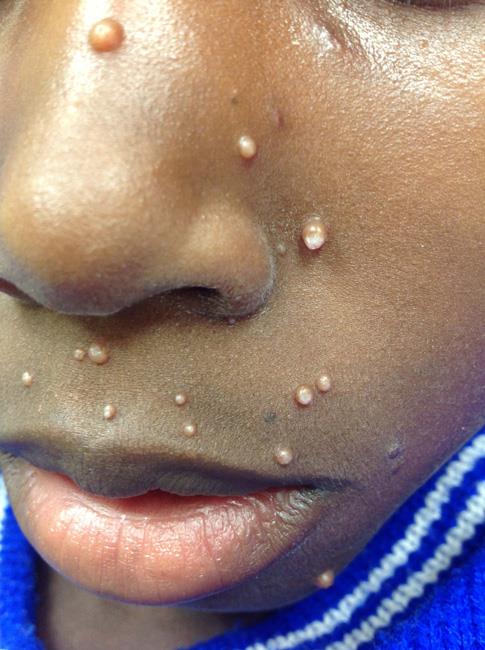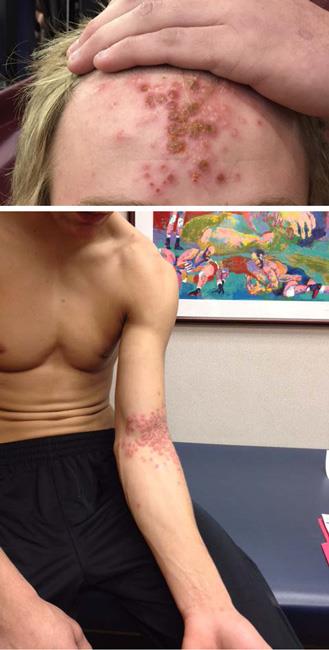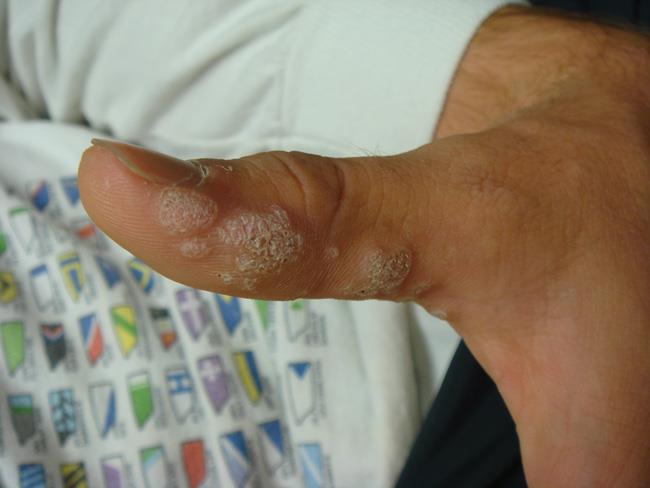Diseases & Conditions
Skin Infections in Athletes
Skin infections are common in athletes of all ages, particularly those involved in high-contact sports like wrestling and football. Infections can be transmitted from one athlete to another directly through skin-to-skin contact or indirectly through contaminated objects such as towels, mats, and equipment.
Although there are many different types of skin infections, symptoms commonly include lesions, blisters, or sores. An athlete who develops any of these symptoms should refrain from training and competition until they can be evaluated by a doctor. Prompt and proper treatment is needed to prevent an infection from worsening and to reduce the risk of teammates becoming infected.
Viral Skin Infections
Viral skin infections commonly seen in athletes include:
- Molluscum contagiosum
- Herpes simplex virus
- Warts
Molluscum Contagiosum
Molluscum contagiosum is caused by a pox virus. Typically seen in young children, the infection can be spread by skin-to-skin contact or by sharing pools, decks, and other wet environments with someone who has the infection.
Molluscum contagiosum causes lesions (mollusca) that usually occur in clusters in the body's creases — such as the underarms, elbow, and behind the knees — although they may appear in other places, as well.
Mollusca are usually small (3 to 4 mm in diameter), pink, and dome-shaped with a small depression, or dimple, in the center. They are often surrounded by an itchy, eczema-like rash.
Treatment. If left untreated, mollusca may eventually resolve on their own. The lesions often spread, however, so it can take from several months to several years for untreated lesions to go away completely. For this reason, treatment is often recommended.
Mollusca are often treated with medications, including:
- Cantharidan. This painless blistering agent is applied in the doctor's office. Several treatments 2 to 3 weeks apart are usually required.
- Imiquimod, 5-fluorouracil, or tretinoin. These topical prescription medications can be applied at home. In some patients, however, they can be irritating to the skin and slow to work.
Mollusca may also be treated with cryotherapy or curettage. In cryotherapy, the doctor freezes the lesions with liquid nitrogen, which causes the cells to die. Curettage is a minor surgical procedure in which the doctor scrapes off the lesions.
Herpes Simplex Virus
The herpes simplex virus (HSV) typically causes a recurrent cluster of tender, burning blisters on or around the mouth or lips. Before these blisters appear, you may feel a burning or tingling sensation in the infected area.
The blisters usually crust over after several days and resolve in 2 to 3 weeks. Because the virus can remain in the skin, reoccurrence in the same location is common.
In wrestlers, HSV often appears in other places on the body — including the neck, torso, and extremities — and is commonly referred to as "herpes gladiatorum." When it affects the fingertip, it is known as "herpetic whitlow."
If the blisters have crusted over, HSV is sometimes misdiagnosed as impetigo (a bacterial skin infection), acne, or eczema, which can lead to a delay in treatment.
Treatment. HSV is usually treated with an oral antiviral drug such as valacyclovir or acyclovir. These drugs work best to shorten the duration of the outbreak if you begin taking them within the first 72 hours of symptoms.
If the virus reoccurs frequently, your doctor may prescribe a suppressive daily dose of either medication. This will help minimize outbreaks and limit missed events and practices.
Warts
Warts are skin growths caused by the human papilloma virus (HPV). Anyone can get warts, but they are frequently transmitted to athletes through contact with contaminated locker room floors and mats.
Warts are usually light brown, yellowish, or flesh-colored. Because they can be mistaken for callouses, your doctor may pare down the thickened area of skin to look for small black dots. These black dots are actually small clotted capillaries feeding the wart.
Treatment. There are a number of treatment options for warts. Some of them require a short period of recovery due to the slight discomfort they cause. These include:
- Cryotherapy. Liquid nitrogen is used to freeze the wart.
- Curettage. A special instrument is used to scrape off the wart.
- Laser therapy. The wart is burned and destroyed with a laser.
- Topical therapy. A blistering agent, such as cantharidin, is applied to the surface of the wart.
These therapies typically require several treatments 2 to 3 weeks apart. Your doctor will talk with you about whether you can participate in practices and athletic events during this time.
Your doctor may also prescribe a topical prescription medication that can be applied at home, such as imiquimod, 5-fluorouracil, or tretinoin. Although these medications require some work on the part of the patient, they are painless, and using them does not usually impact participation in practices and events.
Bacterial Skin Infections
Staphylococcus Aureus (Staph)
Staph is the most commonly transmitted bacterial skin infection in athletes. The infection can take a number of forms, including:
- Impetigo. Patients with impetigo develop clusters of red, round, scaly patches with scalloped borders. These patches are often covered with yellow, honey-colored crust and may spread rapidly over 24 to 48 hours. Unlike the herpes simplex virus, there is no burning or tingling sensation in the area before the patches appear. Impetigo typically appears on the lower face, but it can quickly and easily spread to the extremities and torso.
- Folliculitis. Folliculitis causes small, white pustules to develop within individual hair follicles. These pustules can develop on the scalp; in flexural areas, including the underarms; and on the lower legs or thighs. Folliculitis is easily spread by shaving.
- Carbuncles and furuncles. Staphylococcus aureus can also appear as carbuncles or furuncles. These solitary abscesses are most often seen on the buttocks and thighs, but can appear in other places on the body, as well.
If your doctor suspects that you have a staph infection, they may take a bacterial culture to rule out Methicillin-Resistant Staph Aureus (MRSA) — a serious staph infection that is resistant to many common antibiotics.
Treatment. Most staph infections are treated with oral antibiotics. Carbuncles and furuncles typically require incision and drainage followed by oral antibiotic therapy.
Methicillin-Resistant Staph Aureus (MRSA)
MRSA is a strain of staph infection that has become resistant to common antibiotics over time. Although effective treatment is still available, MRSA infections are often misdiagnosed initially as typical staph infections. This misdiagnosis can prolong the infection and allow it to spread further.
MRSA may take the form of a solitary abscess that requires incision and drainage. It may also take the form of any other type of staph infection, including impetigo and folliculitis.
Treatment. MRSA can be notoriously difficult to clear and often requires prolonged and repeated antibiotic therapy with Bactrim, doxycycline, or clindamycin.
If you experience recurrent outbreaks, your doctor may recommend skin decolonization with chlorhexidine solution (an antiseptic body wash) and nasal decolonization with a prescription antibiotic nasal ointment.
Fungal Skin Infections
A dermatophyte is a type of fungus that can infect the skin, scalp, and nails. Infections caused by dermatophytes can be contracted by touching contaminated soil or by having direct contact with animals, humans, or surfaces that are infected.
Wrestlers are particularly susceptible to fungal infections because of the close skin-to-skin contact in the sport. If misdiagnosed, a fungal infection can persist for months.
Symptoms of a fungal infection vary, depending on its location on the body.
Skin Infection
Patients with fungal skin infections may develop reddish, round patches that measure several centimeters in diameter. These patches often have scalloped, crusty edges that are defined and raised.
Fungal skin infections can develop anywhere on the body, but are commonly seen on the foot, an infection called tinea pedis, or "athlete's foot."
Treatment. For skin infections, your doctor may recommend a topical prescription antifungal medication. Most skin infections resolve within 3 to 4 weeks.
Scalp Infection
Symptoms of a fungal scalp infection include patchy hair loss and crusty sores. If left untreated, a scalp infection may progress to a kerion, a large abscess with permanent hair loss.
Treatment. Scalp infections cannot be cleared with topical antifungal medications. They require oral antifungal therapy with terbenafine or griseofulvin for at least 3 months.
Nail Infection
Fungal infections of the nails (onychomycosis) are very common and increase in frequency with age. Infected nails may thicken, yellow, and crumble. The changes caused by a nail infection can easily be mistaken for traumatic nail damage caused by sports activity.
Treatment. Nail infections require either 3 months of oral antifungal therapy with terbenafine or griseofulvin, or yearlong therapy with newer topical medications that are applied daily directly to the nails. Nail infections are notoriously recurrent.
Preventing Skin Infections
To help reduce your risk for developing skin infections, follow these general guidelines when participating in sporting events and practices:
- Wash your hands often with soap and water. If water is not available, use an alcohol-based hand rub.
- Shower as soon as possible after every practice and game in which you have direct contact with other players.
- Wash and dry your uniform and practice gear after each use.
- Do not share towels, soaps, lotions, disposable razors, or other personal care items.
- Use a protective barrier (such as a towel) between your skin and shared equipment, such as weight-training or sauna benches.
Last Reviewed
September 2021
Contributed and/or Updated by
AAOS does not endorse any treatments, procedures, products, or physicians referenced herein. This information is provided as an educational service and is not intended to serve as medical advice. Anyone seeking specific orthopaedic advice or assistance should consult his or her orthopaedic surgeon, or locate one in your area through the AAOS Find an Orthopaedist program on this website.









